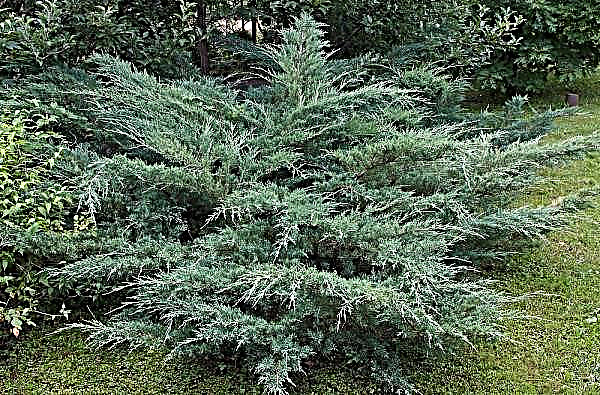Radishes are most often consumed fresh in spring. However, it can also be stored for a long time by canning. In the article you will find popular and simple recipes on how to prepare radishes for use in the winter.
Selection and preparation of ingredients
For preservation, unripe fruits of a large size should be selected, with a dense skin without damage, spots, dents. If the radish is soft when pressed, it means that there are voids in it. Old vegetable will be bitter and ruin the taste of seaming. Before proceeding to harvesting, the fruits must be prepared: thoroughly wash, soak in cold water for 1-2 hours, completely dry and remove the tails.
Did you know? Radish is one of the plants that was grown in space in order to study its genetic characteristics when cultivated outside the Earth. Scientists believe that this vegetable can come in handy during long interplanetary flights.
- Radish, rolled up in cans, is able to provide the following beneficial effects on the human body:
- normalizes blood sugar;
- prevents the development of colds;
- produces urinary and biliary effect;
- cleanses blood vessels and eliminates cholesterol;
- cleanses the body of toxins;
- adjusts appetite;
- positively affects the activity of the digestive tract;
- struggling with vitamin deficiency.
It is useful to use radishes to prevent the development of problems with the heart and blood vessels, cancer, urinary and cholelithiasis, constipation, obesity, gout, diabetes, anemia.

Such useful properties of the vegetable are due to its rich vitamin and mineral composition. It contains vitamins of group B, K, E, beta-carotene, ascorbic acid, calcium, magnesium, phosphorus, iron, iodine, manganese, copper, chromium. When eating 100 g of radish, a third of the person closes the daily requirement for cobalt.
Important! To satisfy the daily requirement of the human body for ascorbic acid, you will need to eat 250 g of radish.
This is a low-calorie product - 100 g of fresh root crops contain 20 kcal. The calorie content of a canned dish will depend on additional ingredients. Do not forget about the dangers of preservation.
- It can not be used in the following categories of persons:
- having problems with the thyroid gland;
- with the diagnoses of “ulcer”, “gastritis”, “pancreatitis”;
- suffering from colitis and flatulence.
Is it possible to eat radishes with other serious health problems, you should consult your doctor.

How to prepare radishes for the winter: the best recipes
In order to be able to use a very tasty and healthy product in the winter, it can be salted whole and in the form of a salad, pickled with cucumbers, dill, green onions, other vegetables and herbs, without sterilization and using this procedure, with and without vinegar. You can learn more about how to prepare radishes by reading simple recipes.
The recipe for salting radishes with tops

4 cans of 0.5 l each for 30-40 minutes and the salting process for 3 days
Nutritional value per 100 g:
- In washed radishes, remove only the tails.
- Cut large fruits into halves or quarters.
- Peel the garlic.
- Remove pepper from pepper.
- Pass pepper and garlic through a meat grinder.
- Cut the onion at an acute angle in the form of feathers.
- Put the prepared ingredients in one container, salt, mix well for the appearance of juice.
- After half an hour, lay out the mass in banks.
- Roll up the covers.
- Keep 3 days at room temperature.
- Subsequently, place in a cool room.
Important! Radish tops contain even more valuable substances than the root crop itself. It can be used for salads, as well as for seafood.
Korean radish diet salad

4 cans of 0.5 l2 hours
Nutritional value per 100 g:
- Chop vegetables with thin strips.
- Mash the radishes with his hands until he gives a sufficient amount of juice.
- Put the vegetable in a colander for a quarter of an hour.
- Place coriander seeds for frying in a pan for 3-4 minutes.
- Grind coriander into powder.
- Pass the garlic through the garlic press.
- Chile cut into rings.
- Finely chop the cilantro.
- Put all the ingredients in one container and mix well.
- Pour in the vinegar and add sugar.
- Put it in banks.
- Screw on the covers.
Did you know? The largest radish was grown by a farmer from Israel Nissan Tamir. He weighed 10 kg. The giant vegetable hit the pages of the Guinness Book of Records.
Canned radish

4 cans of 0.5 l 1 hour, canning time - 2 months
Nutritional value per 100 g:
- Sterilize seaming containers in the oven, above steam or in the microwave.
- Boil the lids.
- Washed radish and garlic cloves cut into circles.
- Put radish in layers, 2–3 cups of garlic, a couple of dill branches.
- Make a pickle: throw salt, bay leaf, pepper into a boiling liter of water.
- Add vinegar.
- Pour the contents of the cans with brine.
- Roll up the covers.
- Turn containers upside down.
- Wrap up for 24 hours.
Important! For winter seals of radish, it is better to choose containers of no more than 0.5 l, so that when opened, eat their contents at a time, since the product should not be stored in open form.
Korean pickled radish with vinegar for the winter

1 can per 0.5 liter
allspice
4–5 peas
Nutritional value per 100 g:
- Cut garlic and radish into thin circles - no thicker than 0.3 cm.
- Put the vegetables in a jar.
- There, place a whole pod of pepper and a bay leaf.
- Prepare the marinade: put sugar, salt, allspice in 0.3 l of water, boil and pour vinegar, oil.
- Pour hot marinade into a jar of vegetables.
- Cool at room temperature.
- Screw on or roll up the lid.
- Keep refrigerated.
Features of storage of blanks
Winter billets can be stored for 1–2 years in the temperature regime from –1 ° С to + 10 ° С, not too high humidity, and no sunlight. The higher the temperature, the shorter the storage time for preservation.

The best places for storing sunsets are a basement, a cellar, a covered balcony, an unheated loggia. Billets that are prepared in full compliance with canning technology, including sterilization, can be stored in room conditions - in the pantry, on the mezzanine, in kitchen cabinets.
Now you know how to cook radishes to enjoy this tasty and healthy vegetable, replenishing your body with valuable elements during the winter period. You can use ready-made recipes that tell you in detail how to salt a vegetable, or supplement them with ingredients to your liking. The main thing is to select high-quality fruits and clearly adhere to canning technology.












